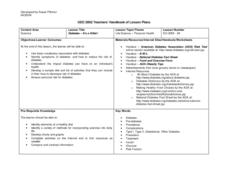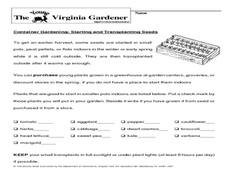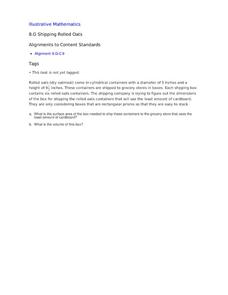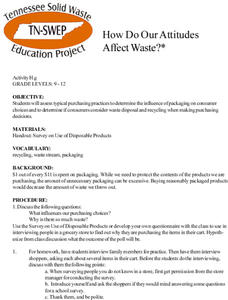Curated OER
Thanksgiving Feast
Use the Tool Factory Workshop to have your class create a list of people to invite to their Thanksgiving Feast.They will take pictures related to the fall season and create invitations using Tool Factory Database. Students make a grocery...
Curated OER
Food: Early American Food Cycles Web Quest
Students complete a Web Quest on ways that Native Americans hunted for, harvested, stored, and prepared food and what types of natural foods were eaten. In this early American food cycles lesson, students discover many of the ways...
Curated OER
Protein Foods
Students examine their protein intake daily. For this adult health lesson, students discover other protein rich foods besides meat. They name examples of vegetarian proteins found in the grocery stores.
Curated OER
Introduce Vocabulary: George's Store at the Shore
Young scholars explore vocabulary words from the story. In this language arts lesson, students discuss vocabulary words from the story. Young scholars discuss the word meanings and use the words in sentences.
Curated OER
Giants Stalk the High Street
Students explore consumerism in Great Britain. For this current events lesson, students visit selected websites to determine how shopping habits have changed in Britain throughout the years. They also evaluate changes in market shares of...
Curated OER
You'd Better Shop Around
Students compare and contrast the prices of various food items at different grocery stores using newspaper advertisements. Students discuss the benefits and drawbacks of shopping around for items that fit within their monthly budget.
Curated OER
Investigating the Food Pyramid
Students examine how the food pyramid is an important nutritional tool. They classify foods and compare the number of servings per group that are necessary for maintaining good health by placing empty food containers in grocery bags.
Curated OER
Diabetes - It's a Killer!
Students survey, graph and chart their prior knowledge about diabetes. They read a handout and complete a K-W-L chart. They develop a rubric to assess their diet and exercise and develop a shopping list, menu and exercise plan to share.
Curated OER
How Far Will You Go And How Much Will It Cost?
Students examine how places of various size function as centers of economic activity. They develop a list of things that families shop for, analyze a local map, create a chart demonstrating how far they travel for the items they listed,...
Curated OER
The Young Virginia Gardener: Container Gardening: Starting and Transplanting Seeds
In this gardening worksheet, students read a short passage about starting and transplanting seeds, then check names of plants they will put in their garden, noting whether they have started it from seed or purchased it from a store.
Curated OER
BY THE POUND
The student will estimate the weight and cost of produce and calculate the actual price.Discuss the difference between weight and volume. Have students discuss whether it is more economical to buy produce by the pound, by the piece or...
Curated OER
Wants and Needs
Here is an outstanding activity on wants versus needs designed for 1st graders. Pupils listen to the book, Something Good which presents themes on wants, needs, choice, resources, and counting money. Pupils complete worksheets embedded...
Curated OER
Shipping Rolled Oats
What better way to start your day than with a box of oatmeal? Or what better way to start your geometry class than by calculating its volume? Eighth graders discover just how practical volume computation can be in business and in breakfast!
Curated OER
Lesson 9: Tracking Commodities
Over the corse of a month, small groups will monitor the price of a specific energy commodity and analyze it in relation to global and domestic events. They play a trade simulation game and create infographics showing what they've...
Virginia Department of Education
A Crystal Lab
Young chemists grow ionic crystals, metallic crystals, and supersaturated crystals in three different lab experiments. Observing these under a microscope allows pupils to compare the various structures.
Houghton Mifflin Harcourt
Silly Stories: English Language Development Lessons (Theme 1)
ESL/ELD learners are provided extra support with the Houghton Mifflin Harcourt thematic units on silly stories by this packet of activities, exercises, and practice sets.
Curated OER
Where Does Food Come From?
Distinguish between food and non-food items. Recognize that food is obtained from both plant and animal sources. Identify sources for some common animal foods then construct a simple food path from the farm to the consumer.
Media Smarts
Packaging Tricks
As part of their study of how advertisers use various techniques to influence consumers, kids examine the design, the promotions, and the product placement in the packaging of their favorite foods.
K12 Reader
Object Pronouns
Take a stab at object pronouns with a straightforward exercise. Give an object, learners determine which object pronoun would be most appropriate to finish 25 sentences.
Curated OER
Reading Comprehension: Obesity and Food Deserts
Read this selection about "food deserts," places where high poverty rates limit access to healthy foods with your class. Six multiple choice questions on comprehension, inferences, vocabulary, and citing the text follow the selection and...
Discovery Education
Blueprint for Life
DNA is the code for all biological traits, both plant and animal. Using an exploratory lesson, learners begin to explore the concept of a biological code by decoding word puzzles. They then extract DNA from plant cells using detergent to...
Curated OER
"Amber Prepared for School" Reading Comprehension-Short Stories
Young students will read a short story about a six year old getting ready to start first grade. Then they answer 10 multiple choice questions.
Curated OER
How Do Our Attitudes Affect Waste?
High schoolers conduct a survey of society's typical purchasing practices to determine the influence of packaging on consumer choices and to determine if consumers consider waste disposal and recycling when making purchasing decisions.
K12 Reader
Apprentice System
As a reading comprehension exercise, kids examine a short article on the apprentice system, and then use information found in the text to respond to a series of comprehension questions.

























